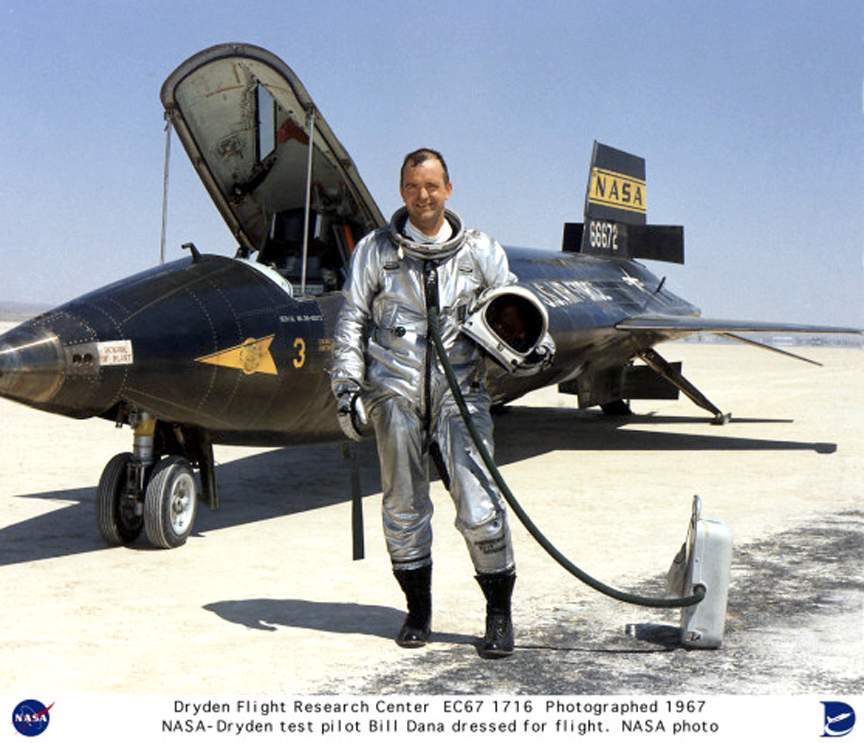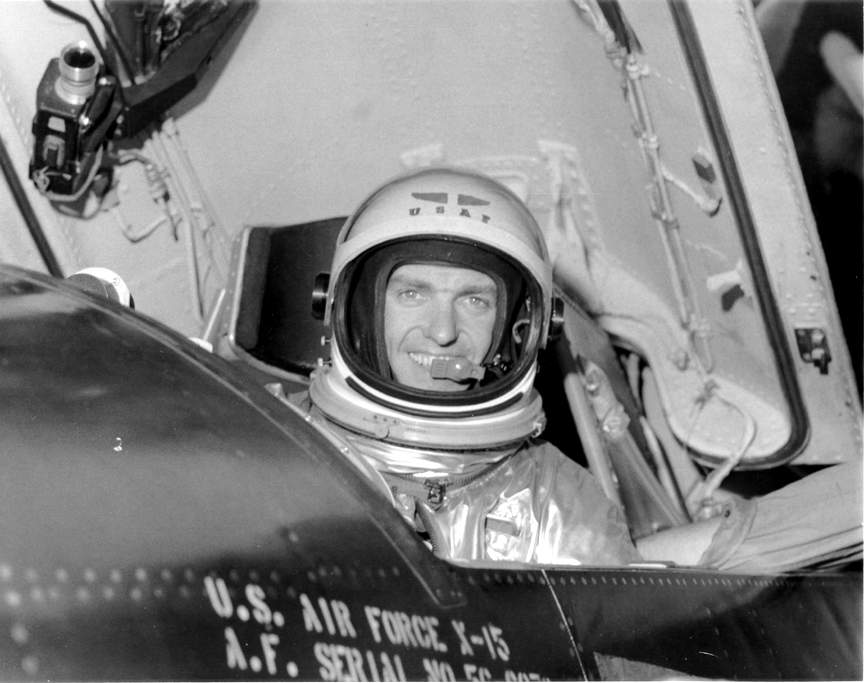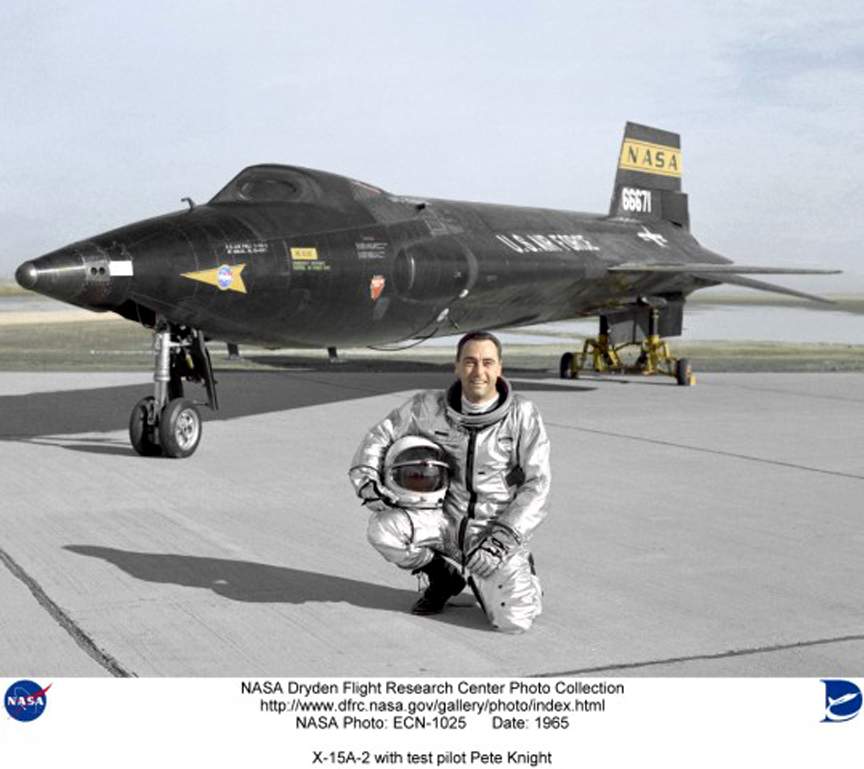| William H. Dana was Chief
Engineer at NASA's Dryden Flight Research Center, Edwards, Calif., from
1993 until 1998, when he retired after almost 40 years of distinguished
service to NASA. Formerly an aerospace research pilot, Dana flew the F-100
variable stability research aircraft and the Advanced Fighter Technology
Integration/F-16 aircraft as well as many others.
Before his assignment as Chief Engineer, he was Assistant
Chief of the Flight Operations Division, a position he assumed after serving
since 1986 as Chief Pilot. He was also a project pilot on the F-15 HIDEC
(Highly Integrated Digital Electronic Control) research program, and a
co-project pilot on the F-18 High Angle of Attack research program.

Dana, born in Pasadena, Calif., Nov. 3, 1930, received
his Bachelor of Science degree from the U.S. Military Academy in 1952
and served four years as a pilot in the U.S. Air Force. He joined NASA
after receiving a Master of Science degree in Aeronautical Engineering
from the University of Southern California in 1958.
As a research pilot, Dana was involved in some of the
most significant aeronautical programs carried out at Dryden. For his
service as a flight research pilot, he received NASAÕs Distinguished
Service Medal in 1997. In 2000 he was awarded the Milton O. Thompson Lifetime
Achievement Award by the Dryden Flight Research Center.
| Les vols de William H. Dana |
| N° du vol |
Pilote |
Date |
Vitesse (Mach) |
Altitude (m) |
Remarque |
| 1-62-103 |
Dana |
04/11/65 |
4.22 |
24.445 |
Premier vol de Dana |
| 3-52-78 |
Dana |
18/07/66 |
4.71 |
29.291 |
_ |
| 3-53-79 |
Dana |
04/08/66 |
5.34 |
40.447 |
_ |
| 3-54-80 |
Dana |
19/08/66 |
5.20 |
54.254 |
_ |
| 3-55-82 |
Dana |
14/09/66 |
5.12 |
77.480 |
_ |
| |
Dana |
01/11/66 |
5.46 |
93.543 |
Premier vol spatial
de Dana |
| |
Dana |
26/04/67 |
1.80 |
16.276 |
Atterrissage de fortune
à Silver Lake après une défaillance du XLR-99 |
| 3-59-89 |
Dana |
17/05/67 |
4.80 |
21.671 |
_ |
| 3-60-90 |
Dana |
22/06/67 |
5.44 |
25.054 |
_ |
| 3-61-91 |
Dana |
20/07/67 |
5.44 |
25.725 |
_ |
| 3-63-94 |
Dana |
04/10/67 |
5.53 |
76.535 |
_ |
| 1-74-130 |
Dana |
01/03/68 |
4.36 |
31.851 |
_ |
| 1-75-133 |
Dana |
04/04/68 |
5.27 |
57.150 |
_ |
| 1-77-136 |
Dana |
11/05/68 |
5.15 |
67.086 |
_ |
| |
Dana |
21/08/68 |
5.01 |
81.534 |
Deuxième vol
spatial de Dana |
| |
Dana |
24/10/68 |
5.38 |
77.724 |
199 ième et
dernier vol |
He was a project pilot on the hypersonic X-15 research
aircraft and flew the rocket-powered vehicle 16 times, reaching a top
speed of 3,897 mph and a peak altitude of 307,000 feet (nearly 59 miles
high). He was the pilot on the final (199th) flight of the
10-year program.
In the late 1960s and in the 1970s, Dana was a project
pilot on the manned lifting body program, which flew several versions
of the wingless vehicles and produced data that helped in development
of the Space Shuttles. For his contributions to the lifting body program,
Dana received the NASA Exceptional Service Medal. In 1976 he received
the Haley Space Flight Award from the American Institute of Aeronautics
and Astronautics for his research work on the M2-F3 lifting body control
systems.
A member of the Society of Experimental Test Pilots,
Dana is the author of several technical papers. Dana is married to the
former Judi Miller. They are parents of four grown children and live in
Tehachapi, Calif.
Joe Engle was born in Abilene,
Kansas, and attended the University of Kansas where he graduated with
a degree in aeronautical engineering in 1955. Commissioned through the
Air Force ROTC program, he earned his pilot's wings in 1958 and was assigned
to fly F-100s for the 474th Fighter Day Squadron and, later,
the 309th Tactical Fighter Squadron at George AFB, California.
Although in command of another squadron, then-Lt. Col.
Chuck Yeager had frequent opportunities to fly with Engle—and against
him in mock dogfights—and he was extremely impressed by the young fighter
pilot's attitude and ability. When Engle applied for admission to the
USAF Test Pilot School at Edwards, Yeager recommended his selection. By
the time he graduated from the school in 1962, Yeager had become the commandant
and, because he considered Engle "one of the sharpest pilots we had in
the program," he immediately selected him for admission to the new Aerospace
Research Pilot School (ARPS) which was being established at Edwards to
train military astronauts.

He graduated from ARPS in 1963 and was selected as a
project pilot for the X-15 program. He completed 16 flights in the rocket-powered
hypersonic airplane, exceeding Mach 5 on ten of those flights and attaining
a top speed of Mach 5.71 (3,886 mph). In June of 1965, he also climbed
to an altitude of 280,600 feet and thereby became one of only eight pilots-all
from the X-15 program-who have qualified for astronaut's wings by flying
an airplane into space. He went on to exceed the Air Force's 50-mile threshold
for astronaut rating on two subsequent X-15 flights.
| Les vols de Joe Engle |
| N° du vol |
Pilote |
Date |
Vitesse (Mach) |
Altitude (m) |
Remarque |
| 1-39-63 |
Engle |
07/10/63 |
4.21 |
23.713 |
Premier vol de Engle |
| 1-41-65 |
Engle |
14/11/63 |
4.75 |
27.676 |
_ |
| 1-43-69 |
Engle |
08/01/64 |
5.32 |
42.641 |
_ |
| 1-46-73 |
Engle |
08/04/64 |
5.01 |
53.340 |
_ |
| 1-48-75 |
Engle |
19/05/64 |
5.02 |
59.680 |
_ |
| 3-30-50 |
Engle |
08/07/64 |
5.05 |
51.938 |
_ |
| 3-31-52 |
Engle |
29/07/64 |
5.38 |
23.774 |
_ |
| 3-35-57 |
Engle |
28/09/64 |
5.59 |
29.566 |
_ |
| 1-51-81 |
Engle |
10/12/64 |
5.35 |
34.503 |
_ |
| 3-40-63 |
Engle |
02/02/65 |
5.71 |
29.931 |
_ |
| 3-41-64 |
Engle |
23/04/65 |
5.48 |
24.292 |
_ |
| 3-42-65 |
Engle |
28/05/65 |
5.17 |
63.886 |
_ |
| 3-43-66 |
Engle |
16/06/65 |
4.69 |
74.585 |
_ |
| |
Engle |
29/06/65 |
4.94 |
85.527 |
Première mission
spatiale scientifique, test d'un capteur infrarouge |
| 3-46-70 |
Engle |
10/08/65 |
5.20 |
82.601 |
_ |
| |
Engle |
14/10/65 |
5.08 |
81.229 |
Premier vol spatial
du X-15 n°1 |
At 32, he was the youngest man to become an astronaut.
When NASA selected him as one of 19 new astronaut candidates in 1966,
he was truly in an unusual position; he was the only one who had already
engaged in spaceflight operations.
First assigned to the Apollo program, he served on the
support crew for Apollo X and then as backup lunar module pilot for Apollo
XIV. In 1977, he was commander of one of two crews who were launched from
atop a modified Boeing 747 in order to conduct approach and landing tests
with the Space Shuttle Enterprise. Then in November 1981, he commanded
the second flight of the Shuttle Columbia and manually flew the re-entry-performing
29 flight test maneuvers-from Mach 25 through landing roll out. This was
the first and, so far, only time that a winged aerospace vehicle has been
manually flown from orbit through landing. He accumulated the last of
his 224 hours in space when he commanded the Shuttle Discovery during
Mission 51-I in August of 1985.
Now retired from NASA, the Air Force and the Kansas Air
National Guard, he currently serves as an engineering consultant and simulation
evaluation pilot for Space Shuttle modifications and other advanced piloted
re-entry vehicles. Joe Engle holds the unique distinction of being the
only astronaut to have flown two entirely different winged vehicles-the
X-15 and the Space Shuttle-into space.
He has flown more than 180 different aircraft types and
logged nearly 14,000 flight hours. His military decorations include the
Department of Defense Distinguished Service Medal, USAF Distinguished
Service Medal and the Distinguished Flying Cross with Oak Leaf Cluster.
Among his many honors, he has been awarded the NASA Distinguished Service
Medal and Space Flight Medal, as well as the Harmon International, Collier,
Lawrence Sperry, Iven C. Kincheloe, Robert H. Goddard and Thomas D. White
aviation and space trophies. In 1992, he was inducted into the Aerospace
Walk of Honor.
Pete Knight grew up in Noblesville,
Indiana, and enlisted in the USAF in 1951. After receiving his commission
through the training in 1953. Flying an F-89D for the 438th
Fighter-Interceptor Squadron, he won the prestigious Allison Jet Trophy
Race in September of 1954. After completing his undergraduate education
with a degree in aeronautical engineering from the Air Force Institute
of Technology in 1958, he attended the USAF Test Pilot School at Edwards
AFB where he graduated later that same year.
He remained at Edwards where he served as project test
pilot on the F-100, F-101, F-104 and, later, T-38 and F-5 test programs.
In 1960, he was one of six test pilots selected to fly the X-20 Dyna-Soar
which was slated to become the first winged orbital space vehicle capable
of lifting reentries and conventional landings. After the X-20 program
was canceled in 1963, he completed the astronaut training curriculum at
the new USAF Aerospace Research Pilot School at Edwards in 1964 and was
selected to fly the X-15.

He had more than his share of eventful flights in the
airplane. While climbing through 107,000 feet at Mach 4.17 on June 29,
and all onboard systems shutdown. After arching over at 173,000 feet,
he calmly set up a visual approach and, resorting to old-fashioned "seat-of-the-pants"
flying, he glided down to a safe emergency landing at Mud Lake, Nevada.
| Les vols de Pete Knight |
| N° du vol |
Pilote |
Date |
Vitesse (Mach) |
Altitude (m) |
Remarque |
| |
Knight |
30/09/65 |
4.06 |
23.348 |
Premier vol de Knight |
| 3-50-74 |
Knight |
12/10/65 |
4.62 |
28.773 |
_ |
| 1-64-107 |
Knight |
12/07/66 |
5.34 |
39.624 |
_ |
| |
Knight |
21/07/66 |
5.12 |
58.613 |
Premier vol de Knight
sur X-15A-2 |
| 2-47-84 |
Knight |
03/08/66 |
5.03 |
75.895 |
_ |
| 2-48-85 |
Knight |
12/08/66 |
5.02 |
70.440 |
_ |
| 2-49-86 |
Knight |
30/08/66 |
5.21 |
30.540 |
_ |
| |
Knight |
18/11/66 |
6.33 |
30.144 |
Le X-15A-2 bat le
record de vitesse du X15A |
| |
Knight |
08/05/67 |
4.75 |
29.748 |
Test de l'influence
d'une maquette de statoréacteur sur la stabilité et
le contrôle du X-15A-2 |
| |
Knight |
29/06/67 |
4.17 |
52.730 |
Panne simultannée
du XLR-99, du SAS et des APU ! Knight parvient in extremis à
se poser après redémarrage d'un APU ce qui lui vaudra
une Distinguished Flying Cross ! |
| |
Knight |
21/08/67 |
4.94 |
27.737 |
Premier test du manteau
de protection thermique du X-15A-2 |
| |
Knight |
03/10/67 |
6.70 |
31.120 |
Record absolu de vitesse
pour un avion piloté, l'appareil est endommagé par
l'échauffement cinétique et ne sera pas remis en service.
15ème et dernier vol du X-15A-2. |
| |
Knight |
17/10/67 |
5.53 |
85.496 |
Premier vol spatial
de Knight |
| 1-76-134 |
Knight |
26/04/68 |
5.00 |
63.093 |
_ |
| 1-78-138 |
Knight |
16/07/68 |
4.79 |
67.513 |
_ |
| 1-80-140 |
Knight |
13/09/68 |
5.37 |
77.450 |
Dernier vol de Knight
et avant dernier vol du X-15 |
For his remarkable feat of airmanship that day, he earned
a Distinguished Flying Cross. Months later, on October 3, 1967, he accomplished
a major milestone, as he piloted the modified X-15A-2 to a speed of 4,520
mph (Mach 6.7)-a speed which remains, to this day, the highest ever attained
in an airplane. During 16 flights in the rocketplane, Knight also became
one of only five pilots to earn astronaut's wings by flying an airplane
in space when he climbed to 280,500 feet on October 17, 1967. After nearly
ten years of test flying at Edwards AFB, he went to Southeast Asia in
1968 where he completed a total of 253 combat sorties in the F-100. Following
his combat tour, he served as test director for the F-15 System Program
Office at Wright-Patterson AFB, Ohio. In this capacity, he became the
tenth pilot to fly the F-15 Eagle and completed some of the initial evaluations
of the fighter. Following a subsequent assignment as Director of the Fighter
Attack System Program Office, he returned to Edwards AFB as vice commander
of the AFFTC in 1979.
During this, his final active duty assignment, he remained
an active test pilot in the F-16 Combined Test Force. After 32 years of
service and more than 6,000 hours in the cockpits of more than 100 different
aircraft, he retired from the USAF in 1982. In 1984, he was elected to
the city council of Palmdale, California, and, four years later became
the city's first elected mayor. In 1992, he was elected to serve in the
California State Assembly representing the 36th District and,
since 1996, he has continued to serve as a state senator representing
California's 17th Senate District. Among his many honors, Colonel
Knight has been awarded the Legion of Merit with one Oak Leaf Cluster,
the Distinguished Flying Cross with two Oak Leaf Clusters, the Air Medal
with ten Oak Leaf Clusters, the Harmon International Trophy, the Octave
Chanute Award, and the Air Force Association Citation of Honor. He has
been inducted into the National Aviation Hall of Fame (1988), the Aerospace
Walk of Honor (1990), and the International Space Hall of Fame (1998).
|


